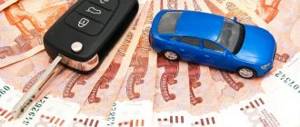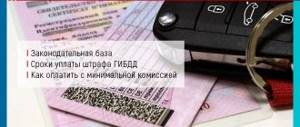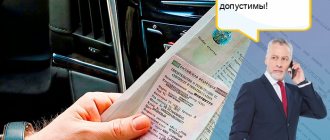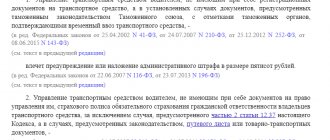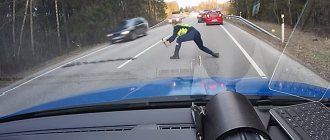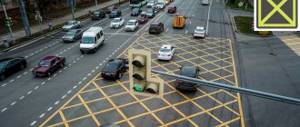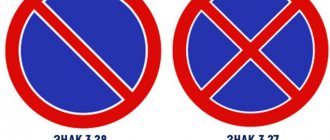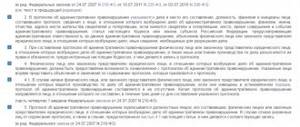Code of Administrative Offenses of the Russian Federation on repeated fines
Administrative Code of the Russian Federation (CAO) in part 5 of Art. 4.1 explains that no citizen can be held responsible for an offense twice. Based on this norm, many drivers have made a rule for themselves - if a fine is issued for violating traffic rules, then another penalty will not be imposed for committing such actions again on the same day. Following this conclusion, some car owners believe that continuing to drive a car after drawing up a protocol and without eliminating the reason for the punishment is quite acceptable. However, this is fundamentally wrong.
Here you should pay attention to Part 4 of Art. 4.1 Code of Administrative Offences. It says that administrative sanctions do not relieve a person from fulfilling the obligation for ignoring which they were imposed. It turns out that the fined driver does not have the right to continue driving his car until he eliminates the reason for the penalty. And if he does do it, he can be punished again on the same day. And it will be legal.
And one more point - the composition of the act. A fine can only be issued for a specific offense committed by the driver on the road. In this case, the traffic inspector must establish the guilt of the car owner and an article of the Code of Administrative Offenses containing the appropriate punitive measure. The traffic police officer is also required to indicate in the protocol the actual time and place of the violation. The legality of repeated punishment on the same day also depends on these data.
Another fine for the same traffic violation will be legal if the new protocol records a different time and place. In essence, such an offense is a new act subject to punishment.
But if the inspector issues 2 receipts containing the same information about the place and time of the violation, then his actions will be unlawful. One of these fines will be illegal.
Are multiple fines for one driver action legal?
First of all, let us turn to the text of Article 4.4 of the Code of Administrative Offences:
1. If a person commits two or more administrative offenses, an administrative penalty is imposed for each administrative offense committed.
2. When a person commits one action (inaction) containing elements of administrative offenses, liability for which is provided for by two or more articles (parts of articles) of this Code and the consideration of cases of which is under the jurisdiction of the same judge, body, official, administrative punishment is imposed within the limits sanction providing for the imposition of a more severe administrative punishment on the person who committed the specified action (inaction).
The essence of this point boils down to the following. The number of fines directly depends on how many actions (inactions) the driver performed:
1. If the driver has committed one action for which punishment is possible under several articles of the Code of Administrative Offenses, then in the end only one fine under a more severe article. This issue is discussed in more detail in a separate article:
Selecting a fine from several articles of the Administrative Code
2. If the driver has committed several actions several fines will be imposed on him .
In theory, everything seems clear, but in practice many people have problems. Therefore, for a better understanding, let’s look at the examples presented at the beginning of this article.
How to avoid being fined again
There are a number of situations in which it is quite possible to avoid penalties for a repeated offense. We are talking about ongoing violations.
Standard situation
The driver's OSAGO policy has expired. The extension requires a visit to the insurer, which is what the car owner intends to do, but in the evening after finishing work. In the morning, a traffic inspector stops him and issues a fine under Art. 12.37 Code of Administrative Offences. Such punishment is absolutely legal. In the evening, when the driver is already on his way to the insurance office, he is again stopped and fined. And this is also legal, because a person has no right to drive a car without a policy. And the situation with his absence has not been corrected. However, repeated collection can still be avoided.
In this case, we can talk about a continuing violation. One in which immediate elimination of the cause of the offense is simply physically impossible. In particular, in order to renew your compulsory motor liability insurance, you need to go to an insurance company.
In such cases, traffic inspectors usually make a note in the protocol or resolution that they have 24 hours to eliminate the violation. During this period, there is no risk of a second fine. It will be enough to present the protocol to the traffic police officer at the next stop.
It may also happen that during the first arrest, the inspector does not provide a day to correct the offense. And here you will have to resolve the issue with another employee yourself. You will need to calmly explain the situation and present a protocol on the already recorded violation. And also inform that right now the driver is heading to the place where the defect is corrected. Most often, traffic police officers meet halfway and do not issue another fine.
Dear reader! Didn't receive an answer to your question? Our expert lawyers work for you. It's absolutely free!
- Moscow ext 152
- St. Petersburg ext 152
- All regions ext 132 (Toll free)
Continuous violations also include:
- technical defects;
- illegal modifications to the design of a car;
- tinting, if it is difficult to remove on site.
In order not to receive another fine on the same day for the above violations, you can also refer to clause 2.3.1 of the traffic rules - going to the repair site with precautions.
In fact, it turns out that the next time a violation is discovered, for which the driver was already fined on the same day, much depends on the opinion of the traffic inspector. In particular, his view on whether the offense can be called continuing. In any case, it is recommended to resolve the issue peacefully and not conflict. Otherwise, there is a high chance of earning a fine again.
Fines for running a red light and for driving beyond the stop line
So, the essence of the situation comes down to the following. The driver received two fines, issued at approximately the same time, for running a red light and for crossing a stop line. He wonders how legal this is. Before proceeding to the answer, try to answer this question yourself.
In fact, it is impossible to answer this question unambiguously, because... the driver did not describe in detail what actions he performed at the intersection.
Option 1: Fines are illegal
This option comes to mind first - the driver of a blue car drives through an intersection at a red traffic light in one go. That is, he simply ignores the requirements of the traffic light:
In this situation, the driver commits only one violation and only one fine should be imposed on him.
If in a similar situation you received 2 fines, then one of the fines should be contested.
How to appeal a traffic police fine?
Option 2. Fines are legal
Let's consider the second option, which is not always obvious. The driver of a blue car drives through the stop line and stops before the intersection. Then he starts driving again and drives through the intersection:
In this case, the driver performs two different actions:
- passes the stop line when there is a prohibiting signal and stops;
- drives through an intersection when there is a prohibitory signal.
The same red light is on at the intersection, but the driver performs two different actions that entail different fines. In this case, there is no point in challenging the decisions.
How to legally challenge a double fine
The legislation of the Russian Federation provides that a citizen cannot be punished and held accountable twice for the same offense.
Even in a situation where one person has committed two or more crimes, the citizen will be punished under the article that provides for a more severe punishment for the crime (Article 4.4 of the Code of Administrative Offences).
According to the legislation in force in the Russian Federation, in particular, Art. 30.3 of the Code of Administrative Offences, fines can only be challenged within 10 days from the date of receipt. In the matter of choosing the place and method of appealing orders, the law (Article 30.2 of the Code of Administrative Offenses) provides for the right of the violator to apply to the traffic police or to the court at the place of registration of the applicant.
Does the inspector have the right to issue 2 or more fines for one stop?
Let's say an inspector stopped you and discovered that you were not wearing a seat belt and your windows were also tinted. In this case, there are two violations, although the second must be proven by measuring a light transmittance device.
And nothing - not a single clause or article of any legal act - prohibits the inspector from issuing as many fines as he likes in the form of decisions for relevant violations. Moreover, the Code of Administrative Offenses directly provides for punishment for each such violation.
Part 1 of Article 4.4 of the Code of Administrative Offenses: 1. If a person commits two or more administrative offenses, an administrative penalty is imposed for each administrative offense committed.
A traffic police officer may issue 2 or more fines for different violations.
Is it legal to impose several fines for the same offense at the same time?
For some violations of traffic rules on the road, the Code of Administrative Offenses provides for sanctions under several articles simultaneously.
Double offenses include:
- driving under the “Entry prohibited” sign and continuing to move along a one-way road against traffic flow - the punishment is provided for in clause 1, clause 3 of Art. 12.16 Code of Administrative Offences;
- changing over a solid marking line into a lane for public vehicles is punishable under Art. 12.19, art. 12.16 Code of Administrative Offences.
It is not possible to issue 2 fines for such violations. In this case, the paragraph of the Code of Administrative Offenses that provides for more severe sanctions for the offense is applied.
The number of penalties for violating traffic rules during the day is practically unlimited. Here everything depends on the act itself, as well as on the loyalty of the traffic inspector. As a general rule, the principle “how many violations – so many fines” is used. However, correcting some offenses takes time, so for technical defects or lack of compulsory motor liability insurance, penalties are usually issued only once a day. At the same time, during one stop, the traffic inspector has the right to impose several fines at once - for each violation he identifies. In the event that liability for a misdemeanor is provided for under several articles of the Code of Administrative Offences, only one of them applies. The one that contains stricter sanctions.
Summation of fines becomes a norm of the code
Traffic police inspectors do not always punish drivers for their violations. They have the right to make do with verbal warnings. This is required by internal regulations of the traffic police, because often a simple conversation works better for drivers than several protocols. In addition, drawing up papers is not a quick task, and traffic police crews already have a lot to worry about. Therefore, police officers at the inspection site independently make decisions about the possible completion of protocols and fines.
However, a new Code of Administrative Offenses (CAO RF) is now being prepared for approval. In the article Art. 21.29 of the code proposes to introduce a so-called “cumulative fine system”, which sums up the number of violations such as exceeding the speed limit, incorrectly driving through a prohibiting traffic light, and so on. If the number of gross violations exceeds a certain limit, the driver will face a very serious punishment.
Comments were made during the discussion of the code, and now it is planned to establish a time period during which the “summation” of punishments occurs. It is proposed to establish a general statute of limitations for bringing administrative liability to one year. At the same time, it is planned to replace the fine for the first minor offense without aggravating circumstances with a warning.
